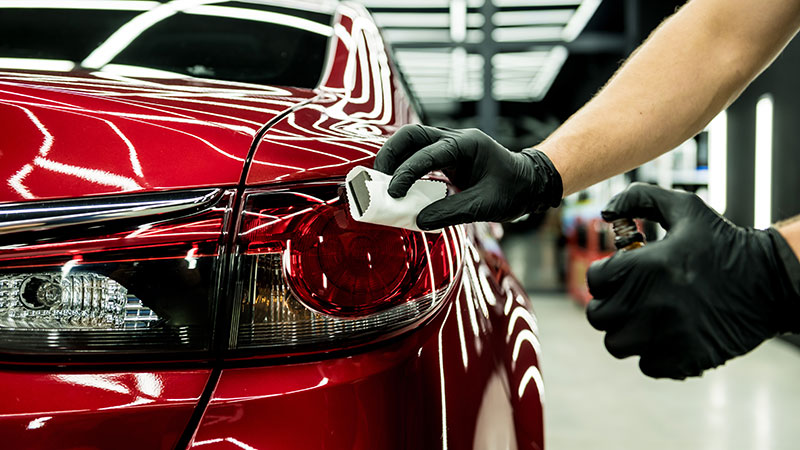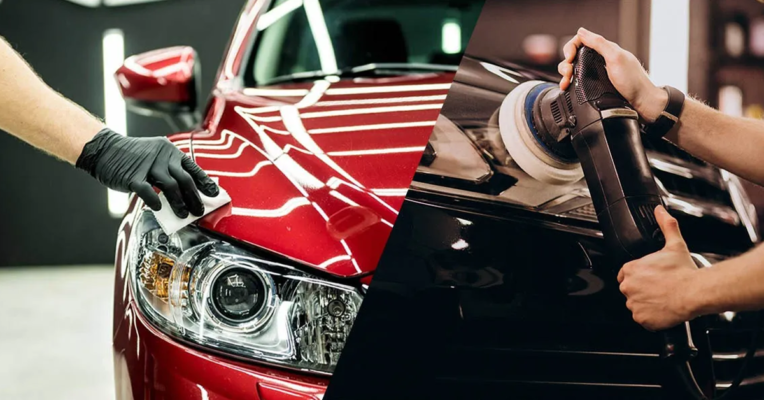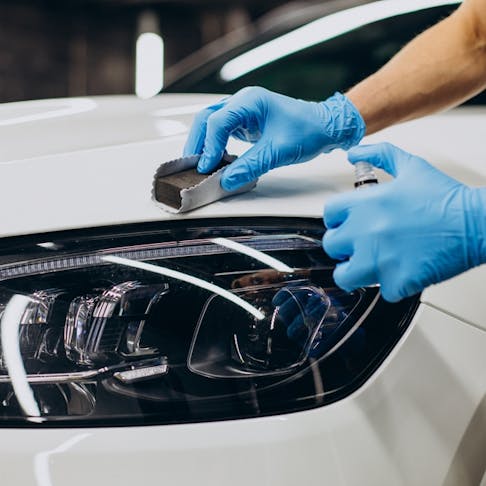Ceramic Pro: Boost Your Auto's Completed with Specialist Coating
Ceramic Pro: Boost Your Auto's Completed with Specialist Coating
Blog Article
The Science Behind Ceramic Finish: Exactly How It Improves Your Lorry's Visual and Sturdiness

Recognizing Ceramic Covering Chemistry
The chemical composition of ceramic coverings plays an essential function in establishing their resilience and protective properties on automobile surfaces. Ceramic layers are generally comprised of silicon dioxide (SiO2), which is a primary component supplying solidity and warm resistance. Various other ingredients such as titanium dioxide, silicon carbide, and polysilazanes are often included to enhance particular residential or commercial properties like UV attachment, hydrophobicity, and resistance.
Silicon dioxide, additionally referred to as silica, creates a transparent and solid layer on the vehicle surface when applied properly. This layer functions as a guard, safeguarding the paint from ecological impurities, UV rays, oxidation, and chemical stains. Titanium dioxide aids in obstructing hazardous UV rays that can cause paint fading and deterioration. Silicon carbide is understood for its abrasion resistance, making the ceramic finishing difficult and sturdy versus physical damage. Polysilazanes are used to improve the layer's adaptability and attachment to the automobile's surface area, making sure durable protection. Understanding the chemistry behind ceramic coverings is essential for both applicators and car proprietors to appreciate the worth and advantages these coverings offer in maintaining the visual allure and durability of cars.
Boosted Gloss and Mirror-like End Up
Understanding the chemical composition of ceramic finishes not just exposes their safety properties but also loses light on exactly how they add to accomplishing an enhanced gloss and mirror-like surface on automobile surfaces. The secret to the shiny impact depends on the nano-ceramic particles present in the layer. These bits complete microscopic pores and imperfections on the surface area, producing a smooth and level surface. As light hits the covered surface, it shows uniformly, offering the appearance of a deep, shiny luster. Additionally, the chemical structure of ceramic finishings enables them to create a strong bond with the car's paintwork, stopping oxidation and maintaining the clarity of the surface with time. This bond additionally stands up to ecological pollutants, such as dirt and grime, that can boring the sparkle of the automobile. The combination of filling buildings, light representation, and long-lasting protection makes ceramic finishes a prominent choice for those looking for a mirror-like and dynamic finish for their vehicles.

Effect On Paint Defense and Longevity
Ceramic finishes for automobiles substantially enhance the durability and defense of the paintwork. By developing a chemically resistant layer in addition to the automobile's clear layer, ceramic coatings act as an obstacle against various environmental impurities that can damage the paint over time. These finishes are created to fend off dust, water, roadway salt, bird droppings, and other damaging substances, minimizing the danger of paint oxidation and rust. In addition, the firmness of ceramic coatings offers a level of scrape resistance, aiding to preserve the lorry's appearance for an extensive period.
In terms of durability, browse around this site ceramic coatings supply a resilient option compared to traditional waxes or sealers. Overall, the safety properties of ceramic finishings contribute significantly to maintaining the automobile's paintwork and improving its visual charm over an extensive duration.
Resistance to Impurities and Harsh Elements
With the protective shield offered by ceramic coverings versus different environmental impurities and aspects, lorries have the ability to maintain their immaculate look regardless of direct exposure to severe problems. Ceramic finishings produce a solid barrier that wards off water, dust, dirt, and other typical contaminants, stopping them from bonding to the vehicle's surface area. This hydrophobic nature not just makes cleansing easier however additionally my review here decreases the danger of water places and etching created by acidic pollutants. Furthermore, the chemical resistance of ceramic finishings helps protect the paint from bird droppings, pest splatter, tree sap, and various other corrosive materials that can damage the surface over time.
Additionally, ceramic layers supply UV security, protecting the lorry's paint from the sunlight's unsafe rays that can trigger fading and oxidation. This resistance to UV damages aids keep the shade intensity and sparkle of the paint for longer periods. By creating a sturdy and durable obstacle, ceramic coverings make sure that the car's outside continues to be safeguarded against a large range of impurities and rough elements, maintaining its visual charm and longevity.
Application Methods and Upkeep Tips
For optimum outcomes when using ceramic finishings to lorries, using appropriate strategies and sticking to recommended upkeep methods are essential. The application process of ceramic covering requires attention to detail and accuracy. Prior to using the ceramic covering, it is crucial to thoroughly tidy and sanitize the car's surface to guarantee proper bond. This involves cleaning, claying, and potentially polishing the paint to produce a smooth canvas for the ceramic finish to bond efficiently.
When using the ceramic finish, it is recommended to function in tiny sections to make sure even protection and to stop the product from more information drying out as well swiftly. Using applicator pads or microfiber towels, apply the finishing in a crisscross or up-and-down motion, depending upon the product's guidelines. After the finishing is applied, allow it to treat for the defined time prior to rubbing off any residue.
In regards to maintenance, routine cleaning with pH-neutral soaps and staying clear of abrasive devices or rough chemicals will aid protect the ceramic coating's integrity. Regular examinations for any damage or endure the layer can also assist maintain its safety residential or commercial properties in time.

Conclusion
Finally, ceramic layer enhances a vehicle's visual allure and resilience with its chemical composition, giving a glossy finish and securing the paint from ecological impurities. Its resistance to extreme components and convenience of upkeep make it a prominent choice for cars and truck proprietors seeking to maintain the appearance of their lorries. Generally, ceramic finishing is a scientifically backed remedy for preserving the look and durability of your car.
Understanding the chemistry behind ceramic finishings is crucial for both applicators and car proprietors to value the worth and benefits these coatings supply in maintaining the aesthetic charm and longevity of cars. (ceramic pro)
Understanding the chemical composition of ceramic finishings not just exposes their protective buildings however also drops light on how they contribute to achieving a boosted gloss and mirror-like coating on automobile surfaces. By creating a chemically resistant layer on top of the vehicle's clear coat, ceramic finishes act as a barrier against different environmental pollutants that can damage the paint over time. On the whole, the safety homes of ceramic coatings add significantly to maintaining the car's paintwork and boosting its aesthetic allure over an extensive period.
In final thought, ceramic covering improves a car's aesthetic charm and sturdiness through its chemical composition, providing a glossy surface and safeguarding the paint from environmental pollutants.
Report this page